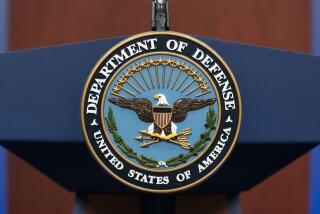U.S., British Troops Given Attacking Role
- Share via
WASHINGTON — American and British troops will conduct most of the offensive operations in a Persian Gulf war--and probably sustain the greatest casualties--while French and Arab forces handle defensive assignments well behind the front lines, military officials said Monday.
The division of responsibility, negotiated over months of discussions by political and military leaders of the allied coalition, reflects continuing uncertainty about the commitment of some Arab allies to participate in a military offensive against Iraqi troops in Kuwait.
The command and control plan also is intended to avert potentially catastrophic communications breakdowns and “friendly fire” casualties that could result from language barriers and misidentification of allied troops and military equipment.
The plan will place American and British forces under the command of Lt. Gen. H. Norman Schwarzkopf, the top U.S. military officer in the field, while the French and Arab forces will be directed by Lt. Gen. Prince Khalid ibn Sultan of Saudi Arabia.
“The arrangement exploits a longstanding relationship that the British and Americans have had in NATO in sharing intelligence and in coordinating military operations,” said Paul Stares, an expert in military command and control at the Brookings Institution. “At the same time, they’ve almost certainly endeavored to minimize the necessity for coordinating their battlefield operations with non-NATO coalition members.”
Although U.S. officials cited military rationales for placing the American and British forces at the forefront of a military thrust against Iraqi occupation forces in Kuwait, they acknowledged that the decision is based on political considerations as well.
A total of 29 nations have deployed more than 600,000 military personnel as part of Operation Desert Shield, with the United States accounting for more than 370,000 of the total, but the commitment of some coalition participants to offensive action is less than certain.
Syria, which has deployed 20,000 troops in Saudi Arabia, has reiterated a longstanding refusal to engage in offensive operations. Egypt, the largest of the Arab forces with 40,000 ground troops assigned to Desert Shield, also has been reticent to join an offensive thrust.
Secretary of States James A. Baker III, in a final round of consultation with allies, won a commitment from Cairo to help push Iraqi troops from Kuwait. Other Arab allies, including Saudi Arabia, also have pledged their willingness to move against the Iraqis.
Even so, military officials said the uncertainty caused by earlier statements by Arab leaders, as well as the military weaknesses of the Arab forces, played a significant role in shaping the planned division of labor among the coalition forces.
“In any discussion of war plans, you can’t keep politics out of it,” said Stares, the Brookings Institution official.
Under the command and control plan, U.S. and British ground forces would lead the allied military offensive in occupied Kuwait, where roughly half of Iraq’s estimated 540,000 troops are dug into elaborate defensive positions.
The American and British ground troops would penetrate deep into Iraqi-held territory, engaging some of Saddam Hussein’s most capable forces to the north while cutting off supply lines to hundreds of thousands of other Iraqi troops in the south.
Meanwhile, the French and Arab forces under the command of Gen. Khalid would be assigned roles primarily as “fixing forces,” staying close to Saudi Arabia’s border with Kuwait and “fixing” Iraqi troops in place by threatening to engage them, officials said.
Others would move in behind the U.S. and British forces and establish rear bases that could prevent breakouts by Iraqi forces and would be used to supply the Western forces as they move farther north, the officials said.
Although the French and Arab forces would be fulfilling essentially defensive roles, their mission still would take them across the Saudi border with Kuwait as part of an offensive operation and expose them to enemy fire.
As a result, the French and Arab troops would suffer casualties, officials said, although in proportionally smaller numbers than the American and British forces who would bear the bulk of the offensive burden.
In the earliest days of a ground war, the command and control plan would require the allies to conduct a difficult and dangerous maneuver called passage of lines.
American and British troops would pass through Arab forces now in positions close to the border in order to move north first. The Arab units would take steps to make themselves distinct from their Iraqi foes.
As coalition forces achieve key symbolic objectives, such as the taking of Kuwait city, some of the Arab forces in the rear would be passed forward to the front--another carefully choreographed movement--so they could march triumphant into the Kuwaiti homeland.
Perhaps the most important mechanism for military coordination, said one official in Saudi Arabia, is a “Coalition, Coordination, Communication and Integration Center” near Central Command headquarters in Riyadh, where officers work in shifts around the clock.
The unit is managed jointly by U.S. Army Maj. Gen. Paul R. Schwartz, who reports to Gen. Schwarzkopf, and Saudi Brig. Gen. Abdulla Batil Harbi, who reports to Lt. Gen. Khalid, the Saudi commander.
The so-called C3I center is responsible for taking new orders or intelligence information and relaying it to the field, as part of the joint Saudi-American operation designed to function like a harness.
Times staff writer Douglas Jehl in Saudi Arabia contributed to this story.
TROOP DEPLOYMENTS
Number of troops deployed in the Persian Gulf region
United States: 370,000+
Saudi Arabia: 117,700
Britain: 35,000
France: 17,000
More to Read
Get the L.A. Times Politics newsletter
Deeply reported insights into legislation, politics and policy from Sacramento, Washington and beyond. In your inbox twice per week.
You may occasionally receive promotional content from the Los Angeles Times.











